
The Steyr Scout is the culmination of Jeff Cooper’s concept of a light yet capable rifle. Image courtesy of the manufacturer.

With two magazines on board, the Steyr Scout Rifle is easily tac-loaded and the operator need not carry additional ammunition on their belt.
For more information, visit https://steyrarms.com.
To purchase on GunsAmerica.com, click this link: https://www.gunsamerica.com/Search.aspx?T=steyr%20scout.
The idea of owning only one rifle does not appeal to many Americans. In some European countries, government restrictions make it more common and is why drillings and vierlings—rifle and shotgun combination guns with multiple barrels—are popular there. In the United States, we can own multiple rifles specialized for almost any specific task. While this is very appealing if not an ideal situation, so is the idea of owning a single rifle you can do almost anything with.
U.S. Marine and Gunsite Academy founder Jeff Cooper began experimenting with carbines – short rifles – as early as the mid-1960s. His work with these reduced rifles led to his conceptualized solution to the one rifle question. Cooper’s Scout Rifle concept is now often looked at as mostly a set of ridged specifications regulating the physical makeup of the firearm. What is very often overlooked is the practical application and friendliness of the rifle Cooper was trying to create.
In the early 80s Jeff Cooper held a number of conferences with riflemen and others he respected. The goal was to put forth the criteria of the Scout Rifle concept Cooper had formulated around the idea of a rifle that would best suit a man working alone in the wild while operating as a military scout, hunter, or both. Though Cooper massaged the specifications over the years, his Scout Rifle could be broken down into these 10 elements.
- Compact bolt-action rifle chambered for .308 Winchester
- Barrel of 19 inches or less
- Overall length of 39 inches or less
- Forward-mounted, low-powered, long eye relief optical sight
- Reserve ghost ring sights
- Ching or C.W. shooting sling, with hammerhead recessed attachments
- Good trigger
- Integrated bipod
- Mechanism for storing extra magazine or ammunition in the buttstock
- Maximum weight of seven pounds unloaded, with all accessories attached
Cooper’s definition went far beyond elemental makeup; he wanted a rifle that was “friendly” and stipulated its most outstanding characteristic was “handiness.” He wanted a rifle that was ideally adapted to the snap shot, while still providing two MOA or better precision out to any reasonable shooting distance. Cooper wanted a “general-purpose” rifle.

This is Cooper’s second prototype Scout Rifle and he called it Sweetheart; it is the rifle Zedrosser from Steyr worked with when he came to Gunsite.
Cooper worked with a variety of gunsmiths trying to construct prototypes meeting these specifications, but what he really wanted was that a major firearms manufacturer to mass-produce his conceptualized carbine. Over the next several years Cooper came close to creating a Scout Rifle with his prototypes, but it was 1990 when a major firearms manufacturer finally showed interest. Cooper met with Steyr Mannlicher to explain his concept rifle, but Steyr was too busy with other projects to commit at that point. However, the idea was not scrapped and Cooper invited Steyr engineer Herr Ulrich Zedrosser to visit Gunsite and try his best prototype Scout Rifle to better understand the concept.
Zedrosser went to Gunsite and was very impressed with how well “Scout II” or “Sweetheart” – Cooper’s second prototype Scout Rifle – worked. Zedrosser immediately began sketching ideas and seven years later the Steyr Scout Rifle was unveiled at the Whittington Center in Raton, New Mexico, in October of 1997. A Steyr press release contained the following description, and it read as though Cooper had written it himself:
“The essential element of the Scout Rifle is handiness. It is a general-purpose arm intended to all things that a rifle might be called upon to do, with the exception of certain specialties, such as formal target shooting and hunting pachyderms. Conceptually, it renders all extant general-purpose rifles obsolete. The man who owns a Steyr Scout has no need for any other rifle.”
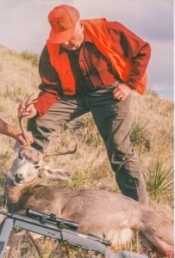
This mule deer is the first game animal Cooper took with the Steyr Scout Rifle. Circa – 1997, Gunsite Academy photo.
SPECS
- Chambering: .223 Rem., .243 Win., 7mm-08 Rem., .308 Win
- Barrel: 19 inches
- OA Length: 38.5 to 39.4 inches
- Weight: 6 pounds, 12 ounces
- Stock: Synthetic
- Sights: Pop up ghost ring rear, blade front
- Action: Bolt
- Finish: Matte black
- Capacity: 5, or 10 with the extended magazine kit
- MSRP: $ 1,499.00
From Dream to Reality
Even by today’s standards, the Steyr Scout Rifle’s appearance is radical, but the radicalness of the Steyr Scout is not in just its looks. The rifle is built on Steyr’s SBS action which has a four lug bolt with a 70° lift. The lugs lock into a bushing with a steel safety ring that leaves the bolt head, case head and extractor, surrounded.
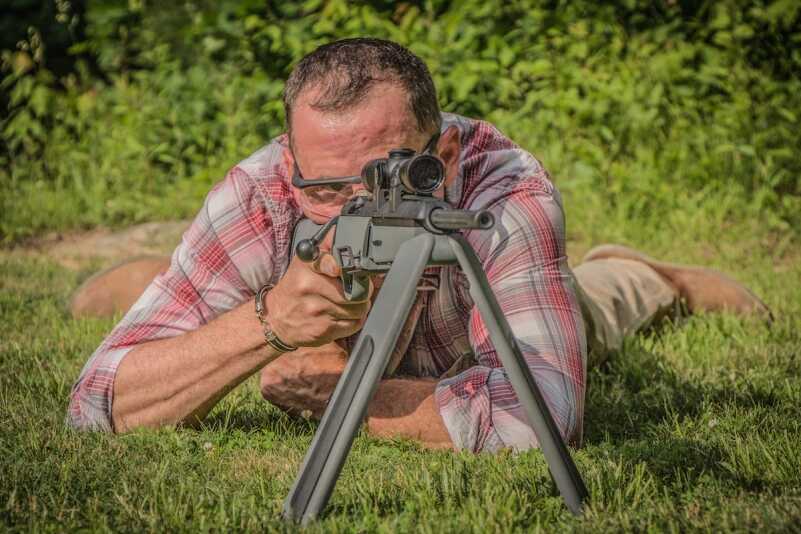
Though the integral bipod on the Steyr Scout Rile is not as rigid or as versatile as say a Harris bipod, it can aid with shooting and is great for resting the rifle.
This system also incorporates a three-position, tang-mounted rolling safety. In the forward “FIRE” position a red dot is visible. In the center position, the trigger is locked and both a white dot and a button are visible on the rolling wheel. With the safety in this position, the bolt can be cycled without worry of negligent discharge. If the button is depressed and the wheel is rolled to the rear “LOCKED SAFE” position, you can press down on the bolt handle and lock it in place. This circumvents the bolt from being accidentally opened if it snags on something. To place the rifle in either the center safe or fire position, press the button and roll the wheel forward. When this is done the bolt shifts out of the locked position.
It’s all a rather ingenious affair and at first blush might seem a bit over engineered. However, with a little practice and use it becomes second nature, blazingly fast to operate, and truly appreciated for its three-position, three-function utility.
Another departure from conventional rifle design is the aluminum alloy receiver, which extends about six inches forward of the front receiver ring. This extension serves as the foundation for the distinctive extended eye relief optical sight (or “scout scope”) that has become so emblematic of Cooper’s concept. The rifle’s thin and fluted 19-inch barrel is joined to the receiver by an interesting arrangement that uses an expanding bushing, tightened to a specific level of torque.
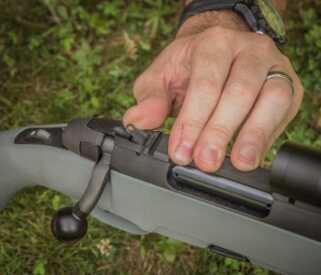
At the rear of the receiver on the Steyr Scout Rifle you will find a pop up ghost ring aperture sight.
Incorporated in the rear receiver ring is a flip-up ghost ring sight adjustable for windage. Recessed in the front barrel shroud is a pop-up front blade sight that can be adjusted for elevation. Together they form the reserve sights Cooper felt a Scout Rifle must possess.
The detachable magazine is made of polymer and holds five .308 Winchester cartridges (other chamberings from .223 Rem. to 7mm-08 are also available). It has the double detent feature that allows it to be locked in place only partially inserted in the magazine well. This allows the operator to load a single cartridge by dropping it through the ejection port. They cartridge will rest on top of the loaded magazine, perfectly aligned so that the bolt can be closed to chamber the cartridge. If access to the full capacity of the magazine is desired the box only needs to be fully seated. Additionally, if the magazine is fully consumed, the operator can continue to load single cartridges through the ejection port or alternately retrieve the spare full magazine that can be stored in the rifle’s buttstock.
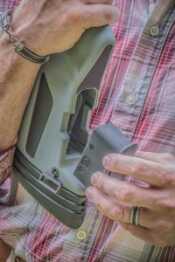
One of the more unique features of the Steyr Scout Rile is the ability to store a spare magazine in the rifle’s buttstock.
Steyr made every attempt to honor Cooper’s concept and engineered a retractable bipod integrated into the rakish lines of the stock. The legs of the bipod are released by a push button in the bottom of the forearm and they fold down and forward. This is counter to most bipods that fold down and to the rear and it will not allow a shooter to load – put pressure against – the bipod when shooting.
Steyr also installed five hammerhead recessed sling swivel slots in the stock to permit the attachment of a traditional two-point sling or the Cooper-preferred three-point C.W. or Ching sling. Rifles are shipped with three hammerhead sling attachments allowing the operator to position the sling as desired.
Finally, and what might be the most overlooked and important aspects of the rifle deal with Cooper’s “friendliness” requirement. The butt of the stock is fitted with spacers allowing the length of pull to be adjusted to fit the shooter and the heel of the butt is rounded to facilitate ease of shouldering. The center of the comb of the Steyr Scout Rifle is very high, only a fraction of an inch below the centerline of the bore, and about 1.75 inches below the center line of a scout scope when mounted as low as possible on the rifle. Additionally, the comb of the Steyr Scout Rifle does not drop—from its nose to its heel—it rises.
This might seem to go against conventional wisdom, but Melvin Forbes of New Ultra Light Arms pioneered this concept when he introduced his model 20 lightweight rifle in 1983. (Incidentally, Forbes stocked a prototype Scout Rifle for Cooper in 1987.) By having the comb configured this way it allows the shooter to establish a solid check weld, while being able to see through the optical sight. More critically, as the rifle recoils the shooter’s cheek slides forward and down the comb. With a conventional rifle stock, with drop in the comb, the crest of the comb is driven back into the shooter’s cheek and the drop prevents the cheek or face from experiencing a comfortable interface.
[one_half]
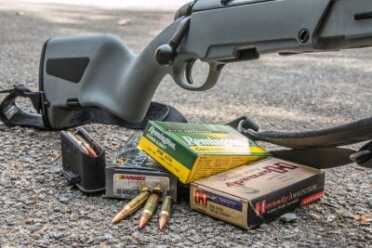
The author ran a selection of Hornady, Remington and Barnes ammo through his test sample rifle with good results.
[/one_half]
[one_half_last]
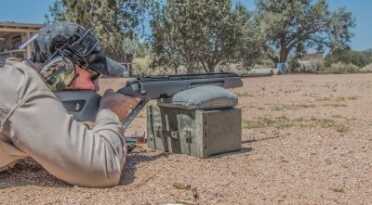
Though many neglect the open sights on the Steyr Scout Rifle and only shoot it with a scout or traditional scope in place, they are an integral and important part of the general-purpose rifle concept.
[/one_half_last]
Tips on Equipping a Scout
An integral part of being a rifleman is the ability to accurately engage targets from field positions. This is best done with the aid of a shooting sling and the Steyr Scout Rifle will easily accommodate any variety. For the purists, I’d suggest the Rhodesian or Ching Sling slings from Andy’s Leather. Both are simple, light, and made of leather.
[one_half]

The Ching Sling, available from Andy’s Leather, attaches at three points on the rifle and works very well with the Steyr Scout Rifle.
[/one_half]
[one_half_last]

Burris’ 2-7X Scout Scope is a versatile scout scope that will work for the snap shot and at distance.
[/one_half_last]
Another option is a sling I worked on with Galco Gunleather called the RifleMann sling. This two-point sling made of nylon and leather allows for comfortable carry of a rifle. It’s also well suited for slinging-up with the support or shooting arm.
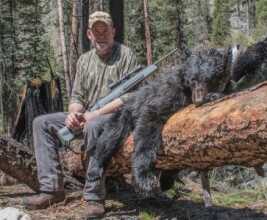
Though not intended as a long-range hunting rifle, the Steyr Scout Rifle took this Idaho black bear at just a shade over 400 yards.
Don’t overlook the fact that you can mount a traditional riflescope on the Steyr Scout Rifle. This allows you to specifically tune the rifle to the application. And, with detachable mounts on your scout scope and traditional scope, you can switch between them, as need dictates. Alternatively, if you want to strictly stick with a “scout” scope, consider the Burris 2-7X Scout Scope with its Ballistic Plex reticle as a good compromise for general-purpose usage.
Finally, I’d suggest ammunition selection be a priority. The shorter barrel of the Steyr Scout Rifle reduces muzzle velocities and this is counter-productive to terminal performance as distance extends. Hornady’s new Precision Hunter ammo loaded with their ELD-X bullet will provide exceptional terminal performance at Steyr Scout Rifle velocities out to 500 yards.
Where It Counts
 Is the Steyr Scout rifle the ideal general-purpose rifle? Is it the only rifle you really need? It just might be. Keep in mind, the Scout Rifle—as Cooper envisioned it—was never intended to be the ideal whitetail, elk, coyote or safari rifle. What Cooper was searching for was the one rifle that could do all these things exceptionally well, while still having serviceable utility for personal defense or in a limited military role. In other words, Cooper saw the Scout Rifle as the one rifle answer to everything. I had a chance to put a sample Steyr Scout rifle through its paces on the range and must say I was very impressed. Although not designed as a “precision” rifle, it is more than capable of effective accuracy and performed quite well. I would say that I agree with Cooper’s assessment of the design and its capabilities.
Is the Steyr Scout rifle the ideal general-purpose rifle? Is it the only rifle you really need? It just might be. Keep in mind, the Scout Rifle—as Cooper envisioned it—was never intended to be the ideal whitetail, elk, coyote or safari rifle. What Cooper was searching for was the one rifle that could do all these things exceptionally well, while still having serviceable utility for personal defense or in a limited military role. In other words, Cooper saw the Scout Rifle as the one rifle answer to everything. I had a chance to put a sample Steyr Scout rifle through its paces on the range and must say I was very impressed. Although not designed as a “precision” rifle, it is more than capable of effective accuracy and performed quite well. I would say that I agree with Cooper’s assessment of the design and its capabilities.
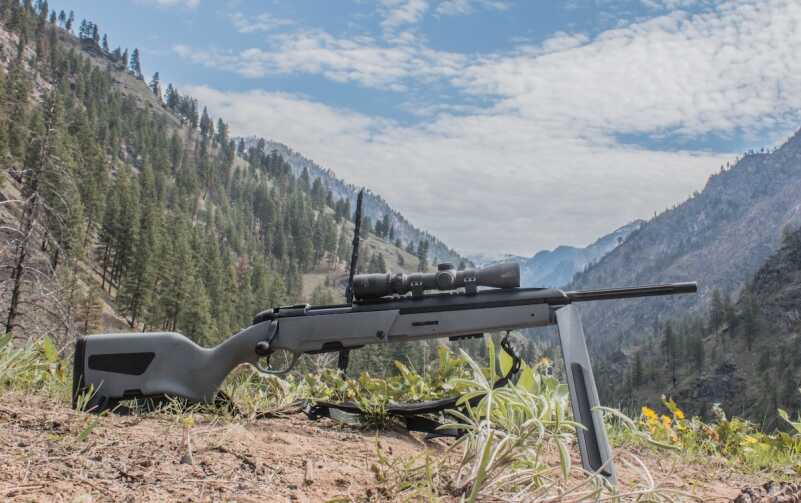
The Steyr Scout is the culmination of Cooper’s musings on the ideal all-around rifle and Steyr’s (successful) efforts to achieve it.
I’m of the opinion Cooper and Steyr got it right. It will excel in just about any situation where volume fire is not a requirement. It can provide reliable service in many roles, while weighing less than any other rifle with all of its features. To me is the epitome of a general-purpose rifle, which is exactly what Cooper wanted, and what the Steyr Scout Rifle is supposed to be.
For more information, visit https://steyrarms.com.
To purchase on GunsAmerica.com, click this link: https://www.gunsamerica.com/Search.aspx?T=steyr%20scout.

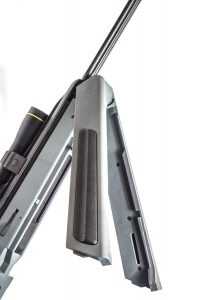
As usual, many seem to miss the point of Scout rifles.
No conventionally-scoped rifle is “handy”. You can’t grip it like a Model 94 Winchester. Yes, scout scopes are not as good as scopes designed to be positioned near your eye. Rather than looking at them as poor scopes, think of them as the best iron sights you will ever use – because they leave the rifle handy just as iron sights do. As to field of view, why does it matter when the scope is far from your eye (obscuring little) and you leave both eyes open?
Where modern scout rifles (like the Ruger) go wrong is with the magazines. All of a sudden, with that big magazine, sticking out, the gun is no longer handy. Why bother with a forward-mounted scope then? And a 16″ .308 is madness.
Cooper got it right. Some people don’t understand it or don’t like it, they don’t have to buy it. It’s poor behavior to carp over others’ preferences in firearms; they should keep their pie hole shut.
My apologies for not mentioning this before; I wasn’t certain that my memory was correct so I did some searching. I also hoped that someone else might have mentioned it.
As with my previous comments about Col. Cooper’s viewpoints, his specification of an LER scope was rooted in the past. It had less – if anything – to do with “handiness” or quick acquisition of a target than it did with his desire that the rifle could be reloaded using stripper clips. The later and current commercially-produced “Scout” rifles all utilize replaceable magazines.
I have always wondered about the later Enfield designs in the same way. Why did they need to provide a removable/replaceable magazine as well as the ability to reload using stripper clips? A “belt and suspenders” solution to be sure…did they really expect that Tommy would lose too many magazines? Wouldn’t a belt full of loaded mags allow for more rapid reloading?
Why, why would I want to buy one of these, when I can get a Springfield A1 Scout for less money and is, I am sure, more accurate. Also, I had a forward mounted scope on a modified 7.62X54 Russian rifle. After trying to hunt with it in Wyoming I unloaded it at Cabalas on the way home.
what you’ve just said is one of the most insanely idiotic things I have ever heard. At no point in your rambling, incoherent response were you even close to anything that could be considered a rational thought. Everyone in this room is now dumber for having listened to it. I award you no points, and may God have mercy on your soul.
What I find interesting is that until relatively recently, when several manufacturers offered “Scout” rifles, the discussion was always about the Scout rifle “concept” rather than a set of specifications for an actual firearm.
As one might surmise from several of the comments in this forum – such as Cooper’s disdain for the 9mm and/or double-action pistols – so far as firearm and/or cartridge design is concerned, the venerable Colonel was living in the past.
Light, short, “handy” rifles in calibers like .308 have had an appeal for hunting beyond anything Col. Jeff might have considered. Remember the Rem 600 and Model 7, or the Win 88 and 100?
As for military applications, the idea of a single “scout,” with few exceptions, was at latest an early to mid-20th century concept. Today, advance scouting typically involves a recon squad; other isolated advance units are likely to be a two-man sniper pair.
FWIW Cooper’s first Scout prototype was based on the Rem 600…
I have a Ruger GSR, put on a leupold 1.5-4 scout scope.. tried to use it for hunting. I had to carry extra binoculars to see in low light, when the deer actually move and come out. The long eye relief combined with the small objective diameter does not work well for hunting in lower light situations. I had to carry the extra weight anyway if I wanted to know what I was shooting. Maybe the Burris 2-7 would have been better. But I just took off that scout scope and put on a vortex 4-12 diamondback. I have been thinking long and hard about what good a scout setup would be used in. I guess if you are hunting in good light it would be ok.. but my experience has been the exact opposite.
Steve, while I do agree that “Scout” scopes are not ideal “for hunting in lower light situations,” I believe that one should not be using a riflescope as a substitute for binoculars in any hunting situation. Find your target with binos first, then zero in on your shot with the scope.
While I think the Scout is a neat concept and a nifty toy, I believe that The Colonel’s ‘Greatest Legacy’ is GunSite and the ModernTechnique.
Amen!!!
Coopers Scout Rifle was absolutely nothing new nor his own idea as gun writers would like you to believe. Either they are all a bunch of sycophants trying to lionize a dead man (which is normal) or they know nothing about the history of military weapons. The Germans had a 98k Rifle equipped with a forward mounted scope in WWII. It suffered from the same problem Coopers Scout Rifle did and that is a lack of field of view.
No one tore the doors off of gun stores to buy Coopers Scout Rifle back in the 80’s despite all the gun writer hype and it was a flop and never caught on nor should it have either.
His scout rifle praise was about as ridiculous as his constant bad mouthing of the 9×19. It was obviously he never shot anything with the 9×19 and when he did use his Scout Rifle he should have been honest enough to admit his concept rifle was a ridiculous failure both technically and with the public as well.
You hit the nail on the head. The German tried out the long eye relief scope on their 98K on the eastern front and promptly dropped it after getting negative feedback from troops.
Colonel Cooper specifically REFUSED to standardize the Scout Rifle Concept on any particular caliber or action type. Any rifle which met the basic standards of size, weight, power and configuration was a Scout.
In fact, he was delighted when someone mounted a Scout scope on a 30-30 Winchester 94, dubbing it the
“Brooklyn Scout” in honor of the town which the maker called home.
The idea of a scout rifle was actually pretty popular around here starting in the mid ’50s and on through the mid ’70s. The reason was because folks were too poor to own more than one rifle, and it better be able to knock down a deer. The only affordable rifles were military surplus, and could be anything the ammo was available for. There were even a few converted Japaniese Arisakas rebarreled to a 30-06 caliblre, which were probably surplus US barrels. None of these actions were easy to mount a scope on, unless you had one of those rare sniper rifles, and most didn’t want to drill and tap for one either. IT was easier to put a “scout scope” on the rear sight mount and swedge that onto the barrel, and make it a carbine lenght barrel. There were very practical home made modifications that didn’t always require an expensive gun smith job. What resulted was a rifle that rattled around in the pickup for years of practical use, and extraordiary tough reliability. I think Cooper tapped into this very practical idea. I for one, would like to tip my hat to this militarly based legacy by insisting on the ability to accpet AR 15 or SR-25 magazines. That is the only way I’d fall for one of these posers, and it better be reasonably priced – just like the originals.
Ideal Scout Rifle, Simple bolt action like Rem. 700, Ruger 77, or Mossberg Patriot, with 24″ barrel, sleek and balanced with receiver sight, Detachable 10 round magazine, in 6.5 Creedmore. Cost in at $600.00. Wood stock, straight stock, Weight 7lbs.
First off, this gun is …U.G.L.Y… Back in the day, as the youngsters like to say, Steyr made handsome, fine-lined rifles. This ain’t one of them.
Second, as for the price, I’m not putting out 14-1500 dollars for a rifle unless it comes with a woman to keep me warm on those cool winter nights. I have several Scout-types, bolt, semi, and even a lever action, and no three of mine together come up to the price of one of these ugly plastic things. I understand Sir Frederick Royce’s quote of not doing anything just good enough, but to triple the cost of anything, for a 1-1.5% increase in performance cannot be justified. Unless you have the backing of the Crown Jewels or have the U.S. Treasury printing money for you.
Have a nice day. JWF
It appears to me that based on the comments far too many people still consider spraying “lead” superior to accuracy. The concept is certainly sound and a rifle with a very stiff short barrel can be extremely accurate out to 250-350 yards and perhaps a really competent marksman can add a couple of hundred yards to that. Personally a well designed bolt action that has the capability of a reasonable magazine capacity such as 10 rounds that has a “short throw” bolt with a very strong extractor is in fact superior to an AR platform. That’s just me but if you feel the need to spray bullets then perhaps you duck as a shooter. I don’t shoot as well as I did 40 years ago but I can still drop a whitetail out to about 150 yards with 1 shot from my 20″ barrel 357 lever gun. I do want to build a Rem 700 short action in 7.62×40 WT with Pacific Tool bottom metal. That way I can use modified AR mags and have power similar to my 30-30. These old bones can’t handle the recoil from my 308 so it now belongs to my son. Oh yeah it’s an M1A1 which is far superior to any AR. Mine is a tack driver. Well it is actually my son’ s now. I do have a really accurate mini-30 too. That style of action is much more dependable than the AR. Sorry for digressing…. I have bolt guns (Mausers) that are over 100 years old that could go to war and not break. If you can’t rapidly operate a bolt fun you need to do some practicing. “Nuff said”
David, you might look into an SMLE converted to 7.62×39 with AK mags. It would give you exactly the sort of capability you’re talking about, with a round that is quite a lot cheaper and superior to the venerable 30-30. I learned with single shot weapons. I think that having only a single shot makes you approach things in a much more deliberate and methodical way. I also am a fan of the Garand and m14, and, given the choice, I will always pick blued steel and walnut over plastic and aluminum. However, I don’t like the places where you use “in fact” to state what is clearly your opinion. Your opinion is not without merit, but it is not “fact.” A great m1a or m14 is a great rifle capable of great accuracy. They are not, however, capable of the same type of accuracy that you can wring out of a 308 AR platform with all things being equal. The difference is similar to the difference between a mini14 and AR15, although perhaps not quite as disparate. Therefore, “superiour” becomes a completely relative term. In 7.62×39 guns, I have an SKS. Compared to your Mini30, it is uglier and made overseas, but it is also significantly sturdier of build, and the tendency is for them to be both more reliable AND more accurate than Ruger’s offering, at about half the price. Even so, I would hesitate to call one superiour to another, in either fact OR opinion. The truth is that the gun that is in your hands when you need it and fires when you pull the trigger is the superiour weapon. To that end, ARs have proven themselves more than adequate. Remember, it is not the rifle, but the rifleman that sprays and prays, and such behaviour predates automatic rifles by many decades.
I had a Vietnam battle field pick up that was a WW2 Arisaka converted to AK ammo using a US MG barrel! The magazine had a stop built into it with a piece of tin so the cartridges would stay stable in use. It was a pretty good shooter. I think I traded it off to a friend of mine who when Ga-Ga on it, and I’d bet he put a scout scope on the rear sight mount to top it off. He is probably busting deer with it to this day. I should have kept it as a museum piece, but I enjoy giving good shooters as much joy as I get from things like this – the reward is seeing more life in folks, and an appreciation of history and practical living.
I agree with your suggestion about an Enfield conversion to 7.62X39 and would love to have one myself. Do you know where and how this can be done currently?
The only place I know of that converted Enfields (No. 4s only, not SMLEs) is Special Interest Arms (http://www.specialinterestarms.com) but they no longer do these.
I don’t understand the spray ammo comment! If you think this scout rifle is the only one that will group, you need to get in the 21century, most of these cheap $250-350. rifles will group as good and better….the Remington 783, will cloverleaf at 100yards all day long, out of the box….Nuff said…
It’s interesting to me that Mr. Cooper’s fascination a single rifle solution still brings out such passion (and argument) in many of us. As several have commented here already, Mr. Cooper had a list of HIS desired features in a light, handy, easy to operate rifle. Well each of us also have our list of features / desires and we’ll all find the solution we are most comfortable with. I think that Mr. Cooper would have looked very kindly on the carbine length AR platform. If you don’t over load it, it’s not very heavy. I put together my own 300 blackout AR and it weighs in at 7.5 lbs unloaded. From what I’m reading here, that is heavier than Mr. Coopers desired list of features, but comes with some advantages. The 300 blackout uses a cut down 5.56 case and can use the exact same mags as the standard 5.56/.223. 30 rounds of 30 caliber goodness in a 16″ to 18″ barreled platform that’s pretty accurate out to 250 to 300 yards if you need to go that far isn’t bad for a general use rifle. While Mr. Cooper seemed (I have never read much of Mr. Cooper’s writings nor am I a student of his scout rifle requirements) to feel that the scout rifle would be used infrequently and was along for the ride mostly as an emergency heavy hitter if needed, I think he would look favorably on thirty rounds in a decent sized caliber that can easily be carried on your back on slung in front. Additionally, because of the collapsible stock it can ride in a pretty compact bag ready to go, or, by separating the upper and lower it can fit into a very short case and sit innocuously behind my seat in my vehicle.
OMG! Not another scout rifle article. To me “one size fits all” means it really doesn’t fit anything well. I wish the alleged “experts” could get over all this Jeff Cooper stuff. I have the utmost respect for the man, but let his ideas rest in peace with him.
The MOSSBERG MVP ‘SCOUT’ Model in 7.62MM NATO is a better choice in my opinion and it’s a $800 less then the Steyr and it comes with a Vortex 2-7x32mm Scope! (http://www.mossberg.com/product/mvp-scout-rifle-scoped-combo-27793/)
I own the MVP Patrol (does not have forward scope mount mount) in 7.62 x 51 and I’m hitting a 15″ steel plate at 210 yards consistently using just the iron sights!
You list an “integrated bipod” as one of Cooper’s requirements for the scout rifle. This is incorrect. Cooper specifically said, in regards to the Steyr Scout, that the bipod was an extra feature that Steyr came up with for their rifle, and that he didn’t mind it because it didn’t hurt or detract from the function of the gun.
He clearly liked the idea, writing favorably about the Clifton stock. It was not a requirement as you say.
Had the 338 Federal been around, I wonder if that would have been on the list?
Great article – thanks!
I looked into this idea the year before
the Sig Brace got the negative memo prior to shot show. I actually owned at the time a 300 blk out in that setup with an EoTech. That set up was extreme agile and would easily trump a bolt within 50 to 100 yards with the following advantages: light weight, quick follow up, light recoil, manuevability, cost, and size. The scout rifle alone concept hasn’t taken off because of technology advances in optics and the AR platform. I no longer own the above fire arm or optic. These days I run a 1 to 6 mag illuminated scope on an 18 Wylde with 45 offset irons. The Scout rifle concepts that made sense have been encorporated
into the modern paradign of fast target shooting, but simply objectifying it by itself is a step backwards.
A carbine in my thinking, is a defense weapon. If I’m hunting, or require high accuracy at longer distance, I wouldn’t carry a carbine.I’d be carrying a long gun, with appropriate optics and range finder. If I’m concerned for self defense, I’d be looking for a weapon that spreads as much lead as possbile in a hurry at intermediate or close range; certainly not a bolt action gun. A Ruger ranch rifle, (Mini Thirty) comes to mind for this task, at a very affordable price. I’m not against Steyr, or being disrespectful of their product; it just doesn’t seem like a weapon I’d carry for hunting OR defense.
I’m constantly amazed at those who believe that they need a 22″ or longer barrel for almost ANY kind of hunting.
Perhaps antelope and sheep or goat, but no way for ANY of the common Deer.
I’ve used a Scout rifle for hunting for well over 10 years, dumping my 24″ barreled .338 Win Mag because of it’s length in heavy timber and getting it out of a scabbard. I too believed I needed that for those long open country shots here in the west. B.S.
If most people honestly believe they will make that 500 yard shot, they’re dreaming.
In 40 years, I’ve made ONE long range (460 yards) shot, and I made that WITH the Scout!
Alan, you are right about those mythical “long” shots in the West. I live in New Mexico and most often hunt the muzzleloader seasons, but for centerfire hunts I have always used my 24″ Win 670 in .30-06. From pronghorn to elk, I have never needed a shot over about 100 yards. Most of my deer and elk hunts are in timber, but my last antelope was taken in open country at about 40 yards. Yes, I am a snob, and a curmudgeon, but I believe that it’s called “hunting,” not “shooting.”
You did read the article and you are aware of the pretense of Jeff Cooper\’s Scout Rifle, right? The one that says \”if you could only have ONE rifle that has to serve multiple duties….\”
And that has what to do with barrel length for hunting????
You DO understand that I was addressing his insinuation that longer barrels for hunting preclude the Scout???????
And that I believe this is utter nonsense?
You see, I have a very high level of comprehension, and have been using a “Scout” rifle for decades, I fully understand the concept.
He also brought up “defensive” use. Cooper was adamant that one does not need all that lead going downrange, one needs to pull back from conflict. Hence the “Scout” concept. No need for high rates of fire.
I’m NOT the one who needs a reminder of the Scout concept
Frankly, I’m not sure you understood my point..
Sorry inkyd62, I though you directed that at me. This is what I get for reading two articles at a time. So much for my claim of a high level of comprehension, eh?
Ah well, a little self criticism is good for the soul! 🙂
I’m impressed !!
Put it out with a 45/70 option and it would be a home run of grand slam proportions.
At least for the north American continent.
I agree, 7.62×39 would also be a big seller. I have a “Scout ” rifle in 7.62×39 that I gave to my son. Everyone who handles and shoots this little rifle immediately wants one. I am still looking for another one in 7.62×39. Wish Ruger would chamber a scout in 7.62×39.
Check out their mini 30. It is a carbine like the mini 14 only it’s in 7.62/ 39 I believe. As far as it being a scout…well you decide if it’s worth it.
Of course it is a great rifle but a pricey one,
frankly I don’t think the forward mounted scope works for a lot of people,
and in the end Cooper was trying to improve on something that needs no real improvement,
the accurized bolt gun, typically the Rem 700,
some things don’t need to be improved or changed
and while you can always supercharge your bolt gun
its not a particularly meaningful improvement in the real world
Mike
I put a 2-7 illuminated reticle scout scope on a mini-14. at 2X with both eyes open you have an unlimited FOV and it is as fast as a red dot at close range, and has plently of precision to the limits of the .223 at 7X. I was skeptical until I tried it.
This might seem to go against conventional wisdom
I have a particular fondness for Steyr rifles and own a couple. They seem to be a brand/manufacturer that has been somewhat forgotten in the US marketplace, even tho they have a notable history of making phenomenal firearms and are known the world over for their barrel manufacturing processes, long life, and accuracy.
I’ve always liked the scout and oogle over them often but simply live in an environment where one would have little to no use for me other than a collection piece (which isnt a bad reason at all). I tend to target shoot and so have a few rifles that focus on that. Bench and prone in controlled environments is what I got, not the great out of doors and the wild lands out yonder. . .tho I like the idea of it.
I see them available in the $1300 range here and there. I think these are the most favorable price points I’ve ever seen them at. Their capacities can also be increased to the 10-round magazine with the installation of a simple to install adapter for that longer magazine. So folks that might balk at it’s capacity when compared to the likes of Ruger and Mossberg should know this can be addressed. Tho a scout rifle and the concept tends to mean a handy rifle that gets carried a lot and shot infrequently and so not necessarily needing a high-capacity, but we folks sometimes like to hear and know that we can go “big time” ‘cos we want to.
I sure hope I see and hear much more about Steyr offerings. They have some really great firearms IMO.
Your specs are not what Col. Cooper specified. It makes reading the rest of your article difficult.
Mr. McNamara,
Since the description used in the articles was taken from words Cooper wrote, maybe you should be more specific in your criticism.
I recently researched a good deal of Col. Coopers writings from the 90’s on, looking specifically at his list of requirements for a scout rifle. Your list above is a possible solution to the requirements, not actual requirements. For instance, you call out a bolt action rifle, while Col. Cooper was clear that a semi-auto was not automatically excluded. There were just not any in his day that met the weight and length requirements.
The requirements outlined by Col. Cooper were:
1. Action – reliable and smooth.
2. Feeding – easily reloaded, common options being stripper clips or detachable box magazine. Ability to easily top-off, or lock out the magazine for single loading a plus.
3. Weight – 3kg ideal, 3.5 kg max
4. Length – 39″ max length (1 meter)
5. Sights – Fixed power long eye relief forward mounted scope
6. Accessories – Sling for both carrying and shooting stability eg. Ching Sling. If a bipod can be integrated and make weight, great.
7. Caliber – Full power readily available rifle caliber as allowed by local law, with 243/6mm being the lower bore diameter limit
8. Accuracy – 2 MOA or better
You will note that except for item 5 he refrained from specifying a solution, but instead specified a requirement. And other places in his writings he did clarify that iron sights were perfectly acceptable. I would also think that many of the modern lower power variable scopes would meet the actual sight requirement of a rapidly acquired heads up style sight or optic that also facilitates medium range shots.
I recently built an AR-10 with an eye to these specs. I actually liked the “Lion Scout” concept, so I used a 358 Winchester barrel. I ended up with a gun that tipped the scales at 6lbs 11 oz with iron sites and measured 33″ with the stock collapsed. A red dot could be added with no weight penalty if the rear sight were removed and the FSB were exchanged for an aluminum low profile. An AR Optics scope would put the gun right at the 3.5 kg max.
I used a TN Arms polymer lower, a titanium bcg and a home grown aluminum free float tube to make weight, and a collapsible stock to help with length. The gun is very handy and fast to maneuver, but a price is paid in increased recoil when shooting 280 grain lead hard cast. None the less, it is about my favorite long gun due to it’s raw utility. In fact, I am thinking about building a version in 243 or 260 as an AR Pistol, just so it will count legally as a handgun for concealed carry in my truck.
Excellent report on a fine rifle. Thank you, Mr. Mann!
PS Some minor adjustments are in order. The Steyr Scout was released in 1997 not 1977. Jeff Cooper founded the American Pistol Institute (API) at Gunsite Ranch in 1976. Gunsite Academy was established by Buz Mills in 1999.
Mike,
You are correct on both accounts. The 1977 was my typo. However, I would add that Gunsite Academy is celebrating its 40th Anniversary this weekend. 1976 – 2016. The history of Gunsite is one I have told in print before and while I could have hashed out the specifics of the name changes and ownership in this article, it simple has no bearing on the topic. The school Cooper started in 1976 exists today, under another but similar name.